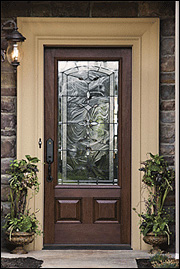Parts of An Entry Door
 Today's entryway doors are fully integrated systems designed to provide great performance, security, energy-efficiency and a lot of style to complement your home's architectural design.
Today's entryway doors are fully integrated systems designed to provide great performance, security, energy-efficiency and a lot of style to complement your home's architectural design.
To understand how your entry door functions, it is important to know what components go into a typical door system and the role that each plays.
Here are descriptions of many of the key components of a door system, courtesy of Therma-Tru®, the nation's largest manufacturer of fiberglass and steel exterior doors:
- Brick mould: The decorative molding used to finish the exterior face of a wood frame at the wall joint.
- Casing: The interior trim molding around the door opening that covers the gap between the frame or jamb and the wall.
- Doorlites: Decorative glass assemblies that are fitted into the door for added beauty and sunlight.
- Sidelites: Fixed or assemblies that are attached adjacent to the door frame.
- Transom: The decorative glass assembly that is installed above the door frame.
- Drip Cap: A horizontal molding placed above the door to divert water away from the door frame.
- Frame: The wood structure that encloses and supports the entire door system.
- Insulated Foam Core: A material blown into fiberglass and steel doors to reduce their ability to conduct both heat and cold.
- Hinge: The metal plate mounted on the door frame that anchors the door to the frame and allows the door to open and close freely.
- Jamb: Vertical side and head trim that enhances the aesthetics of the frame assembly.
- Panel: The raised or recessed, decorative section of a door that produces deep shadow lines.
- Sill: The horizontal bottom frame of a door that supports the weight of the entire door system.
- Weatherstripping: A fixed or adjustable seal along the edge of the door frame that keeps water, air and sound from penetrating a home.
- Sweep: A weatherstripping attached to the bottom of the door.



.png)
.png)
 Today's entryway doors are fully integrated systems designed to provide great performance, security, energy-efficiency and a lot of style to complement your home's architectural design.
Today's entryway doors are fully integrated systems designed to provide great performance, security, energy-efficiency and a lot of style to complement your home's architectural design. 
